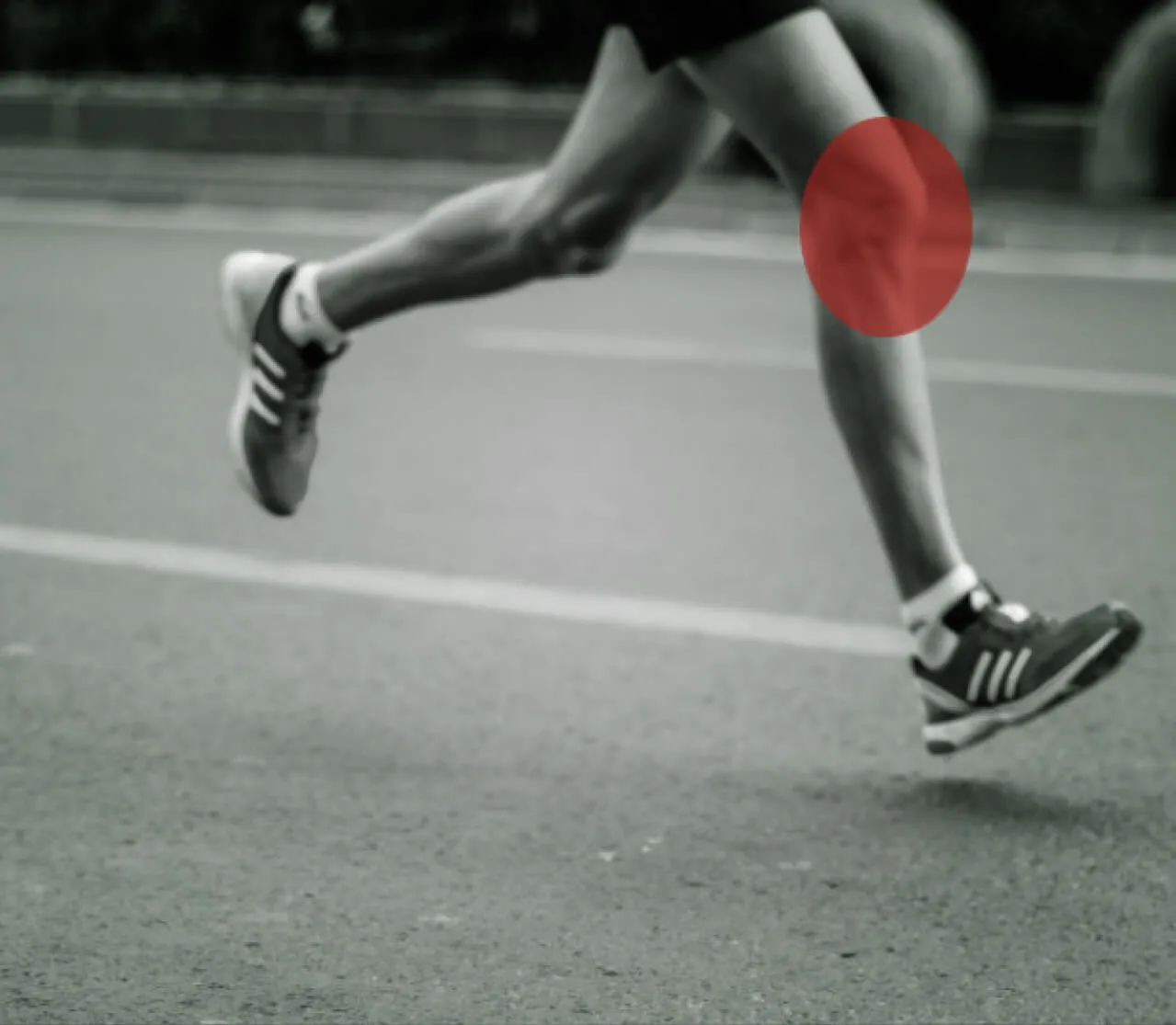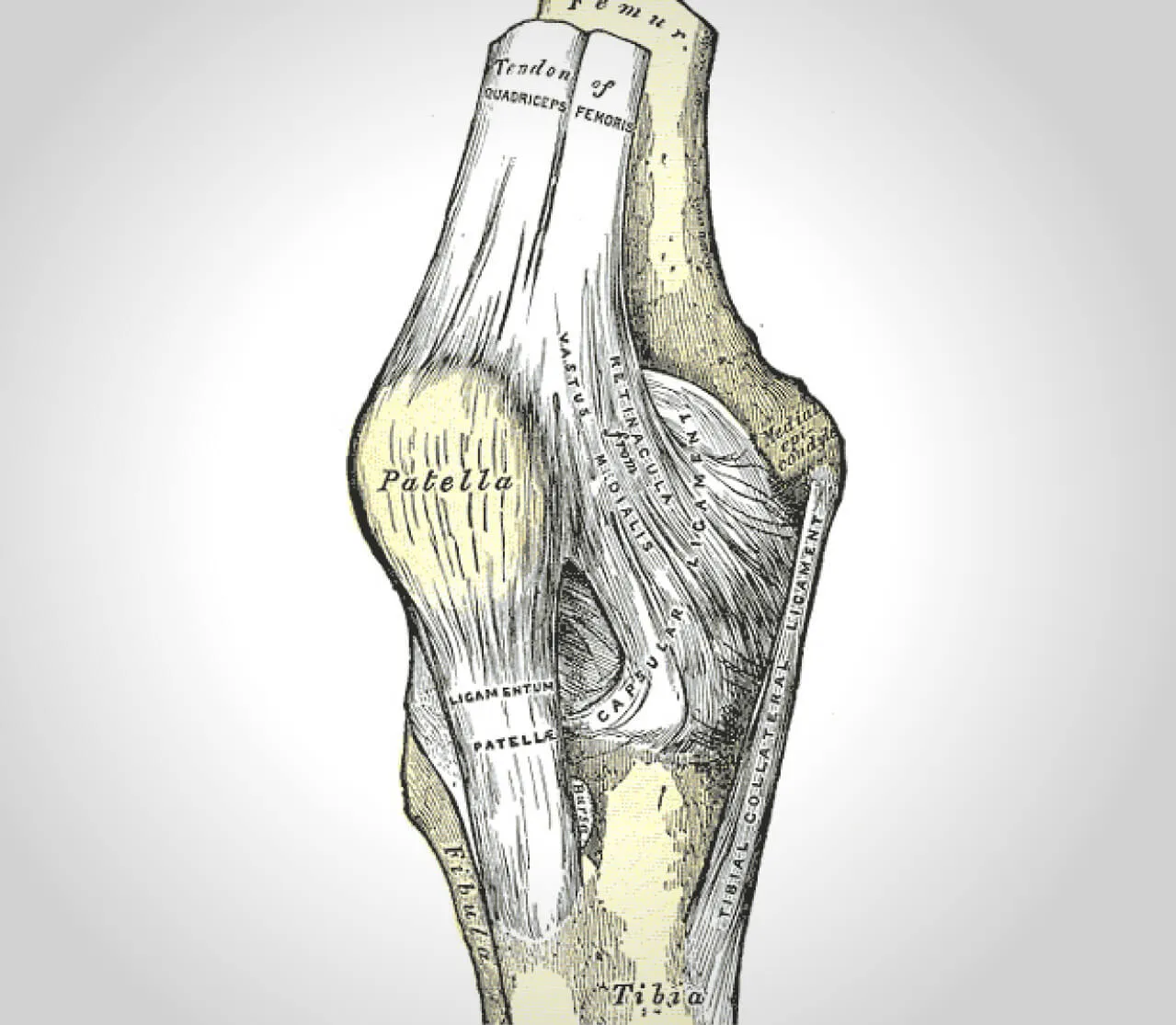Patellofemoral syndrome
There is no clear definition of patellofemoral syndrome. It occurs when there is an overload between the femur and the patella due to a compression effect, which leads to irritation of this joint.
Synonyms for patellofemoral syndrome
- Patellofemoral syndrome
- Runner's knee
What is patellofemoral syndrome?
There is no clear definition of patellofemoral syndrome. It occurs when there is an overload between the femur and the patella due to a compression effect, which leads to irritation of this joint.
What is the kneecap?
It's a bone called a 'sesamoid' because the bone is located within a tendon. The patella is located in front of our knee. Its main role is to allow our quadriceps tendon to have a greater lever arm for making knee movements. The patella, therefore, acts as a pulley for our quadriceps and allows our quadriceps to have more strength.
What is the femur?
It's the large bone in the thigh.
What are the causes of patellofemoral syndrome?
Patellofemoral syndrome is caused by an overload on the structures in front of the knee (the patella and the patellar tendon).
"In other words, if we put more stress on our knee than it is used to receiving, we can develop patellofemoral syndrome."
Here are some classic examples of developing patellofemoral syndrome:
- Going on a full day of mountain hiking when you are not trained for it
- Starting our running or cycling season without pacing the progression (or rapidly increasing the volume of running training)
- Starting a new sport that requires jumping or running without pacing the progression (soccer, basketball, volleyball)

What are the risk factors for developing patellofemoral syndrome?
Here are some elements that are risk factors:
- Boys are more affected than girls.
- Having a significant and sudden growth spurt.
- Participating in sports with repetitive jumping or sprinting.
What are the symptoms of patellofemoral syndrome?
The most common symptoms are:
- Pain in the front of the knee that can also be behind or around the patella
- The pain generally appears gradually, without a specific cause reported by the patient.
- The pain may be increased by:
- Doing a squat
- Going up or down stairs
- Running
- Walking
- Jumping
- Sitting for long periods
Note that the pain is often diffuse and difficult to pinpoint.

How is patellofemoral syndrome diagnosed?
Diagnosis is possible based on the history of symptoms and a clinical examination. X-rays cannot detect patellofemoral syndrome.
When should you see a physiotherapist for patellofemoral syndrome?
You should consult a physiotherapist if you have symptoms as described above or if your doctor has already ruled out any other cause that may be responsible for your pain.
You do not need to see a doctor before consulting a physiotherapist. If your condition requires you to see a doctor, your physiotherapist will be able to tell you.
What physiotherapy treatments are available for patellofemoral syndrome?
Your physiotherapist will perform an evaluation to determine the cause of your patellofemoral syndrome and will assess the following elements:
- Your joint mobility
- The gliding of your nerves
- The quality of your movements
- Your strength and stability
Based on the assessment results, your physiotherapist will:
- Mobilize your knee to reduce pain and improve your movement
- Give you specific exercises to retrain the control of your knee movements.
- Give you exercises to regain mobility, reduce pain and regain your muscle strength.
- Teach you how to properly manage your daily activities and hobbies to optimize healing
- Give you advice for your posture and movements.
What can you do at home for patellofemoral syndrome?
Temporarily stop doing movements that cause too much pain, and then gradually start doing them again.
Here are some tips that may help:
- Engage in transfer activities that reduce stress on the area, such as swimming or pain-free cycling.
- Do strengthening exercises for your glutes.
- Wear a knee brace or compressive bandage temporarily for painful activities.
If you don't see any improvement after 10 days, you should consult a physiotherapist.
If you are a runner, please refer to the blog article on running (link to come) for concrete tips for running.
To learn more…
You can listen to the podcast PARLE-MOI DE SANTÉ created by one of our physiotherapists, Alexis Gougeon.
Episode #1 discusses the prevention and treatment of running injuries.
Find the episode on YouTube:
Click below to listen to episodes on podcast platforms:

(4).png)
Sources
- Gaitonde DY, Ericksen A, Robbins RC. Patellofemoral Pain Syndrome. American Family Physician. 2019 Jan 15;99(2):88-94.
- Bump JM, Lewis L. Patellofemoral Syndrome. InStatPearls [Internet] 2020 May 24. StatPearls Publishing.
- Dubois, B. (2019). La clinique du coureur, la santé par la course à pied. Mons Eds.
Videos in this category
Other conditions
Hip osteoarthritis is a normal wear and tear of the hip joint. Osteoarthritis is often described as the wearing away of cartilage between our bones. While this is true, it involves more than just cartilage. Cartilage is a tissue that acts like a cushion between the surfaces of our bones, allowing our joints to glide smoothly and move with ease.
It is a normal wear and tear of the knee joint. Osteoarthritis is often described as the wearing away of cartilage between our bones. While this is true, it involves more than just cartilage. Cartilage is a tissue that acts like a cushion between the surfaces of our bones, allowing our joints to glide smoothly and move with ease.
It is a normal wear and tear of the joints in the lower back vertebrae. Osteoarthritis is often described as the wearing away of cartilage between our vertebrae. While this is true, it involves more than just cartilage. Cartilage is a tissue that acts like a cushion between the surfaces of our vertebrae, allowing them to glide smoothly and move with ease.
A bursa is like a small, very thin, fluid-filled sac found in several joints throughout the body. This small sac acts as a cushion in the joint and lubricates structures that are exposed to more friction.
It is an inflammation of the subacromial bursa in the shoulder joint.
It is a tissue that surrounds the shoulder and allows the shoulder bone to stay in place within the joint. The capsule helps to stabilize the joint.
Cervicalgia is a general term to describe neck pain that does not have a specific cause, such as an accident or sudden movement. Cervicalgia is therefore synonymous with ''I have a pain in my neck and nothing in particular happened''.
In both injuries, there is pain felt in the neck that then radiates into the arm, or vice versa.
It is a significant stretch or tear of the muscle fibers in the groin or inner thigh muscles.
It is a significant stretch or tear of the muscle fibers in the hamstring muscles located at the back of the thigh.
This is a significant stretch or tear of the muscle fibers in the calf muscles (soleus and gastrocnemius).
This is a significant stretch or tear of the muscle fibers in the quadriceps, which is the large muscle at the front of the thigh.
Book an appointment now
We offer a triple quality guarantee: optimized time, double physiotherapy assessment, and ongoing expertise for effective care tailored to your needs.


Our clients' satisfaction is our priority.
At Physioactif, excellence defines our approach. But don't take our word for it, see what our patients are saying.
Discover our physiotherapy clinics
We have multiple locations to better serve you.
Blainville
190 Chem. du Bas-de-Sainte-Thérèse Bureau 110,
Blainville, Quebec
J7B 1A7
Laval
Montreal
St-Eustache
Vaudreuil
21 Cité-des-Jeunes Blvd. Suite 240,
Vaudreuil-Dorion, Quebec
J7V 0N3
Book an appointment now

